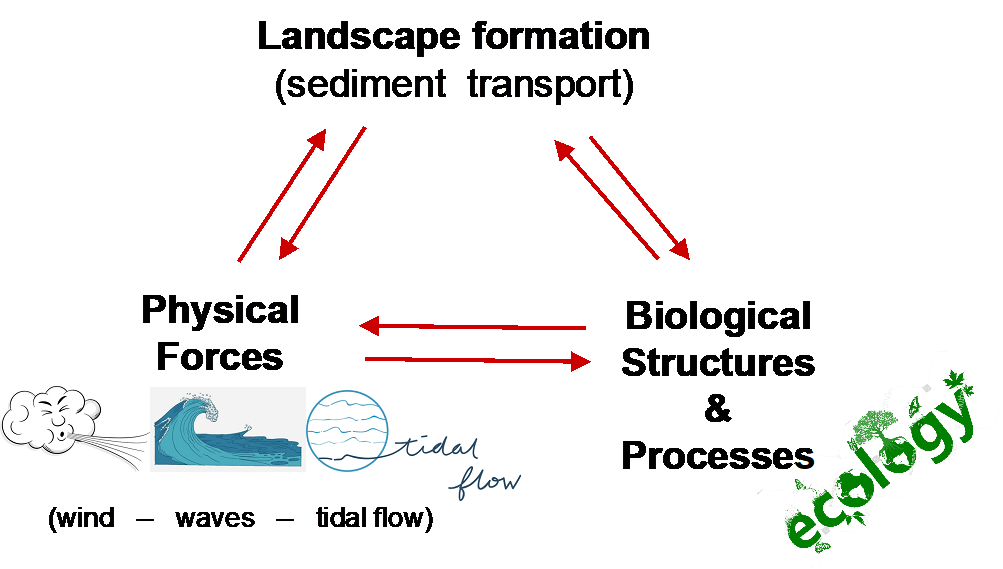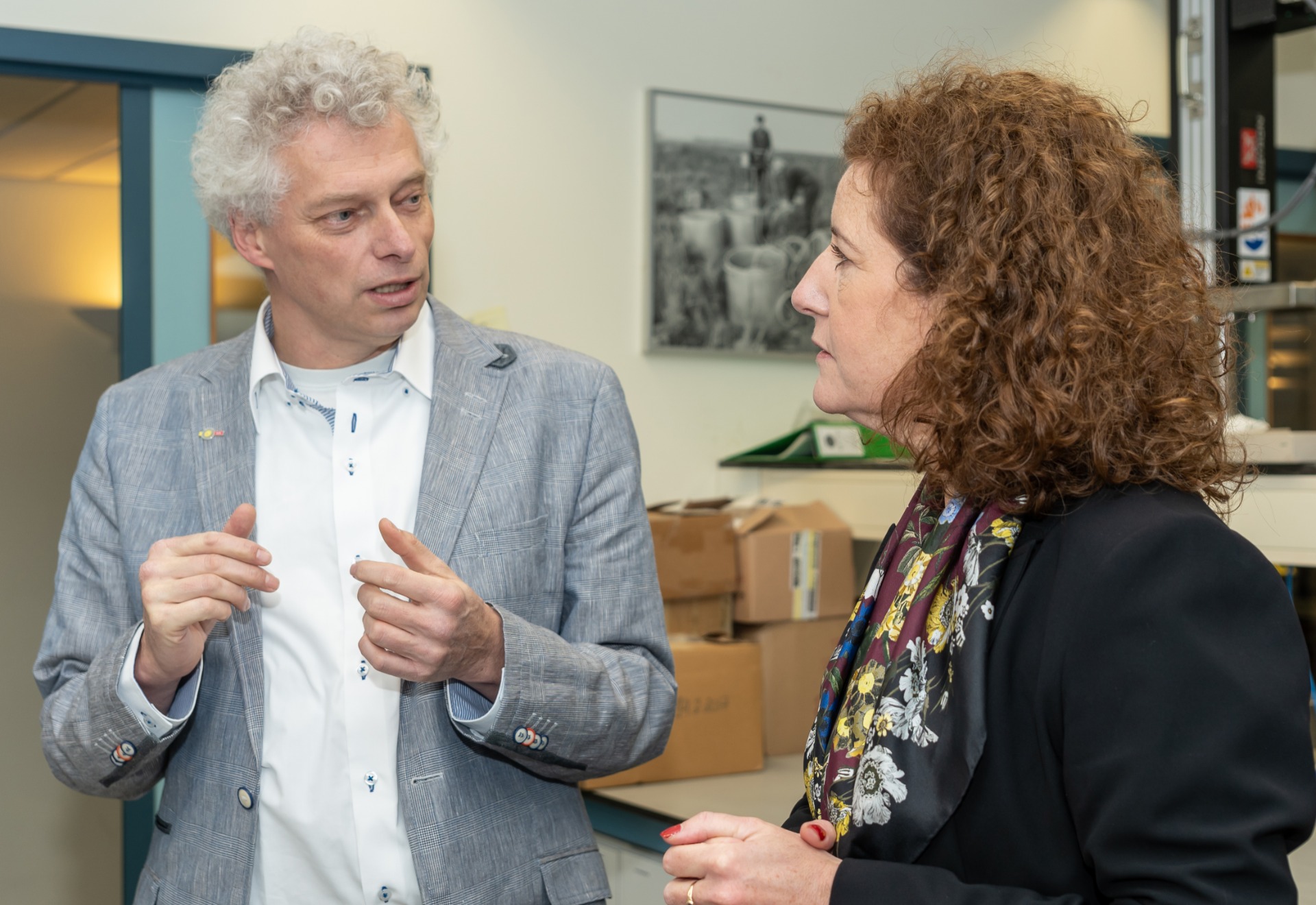Kustbescherming gebaseerd op de natuur: klimaatbestendig?
~~~ for english scroll down ~~~
Dijken worden sterker als we de biodiversiteit in de dijkbegroeiing verhogen. Zeegrasvelden voor de kust kunnen tropische stranden duurzaam beschermen. De natuur draagt zo bij aan de veiligheid van bijna alle kustbeschermingssystemen.
Veranderende plantensoorten
Maar ecosystemen die we willen inzetten voor kustbescherming zijn ook kwetsbaar voor de gevolgen van klimaatverandering. De opwarming van het klimaat verandert plantensoorten. Dat inzicht begint zich nu te ontwikkelen. Het kan grote gevolgen hebben voor de stabiliteit en effectiviteit van dergelijke vormen van kustbescherming waarbij de natuur een grote rol speelt.

Hevigere stormen
Ook de frequentie en intensiteit van stormen veranderen als gevolg van klimaatverandering. Maar over het effect daarvan op de kustbescherming weten we nog bijna niets. Om dit te onderzoeken heeft het NIOZ nieuwe, unieke onderzoeksinstrumenten ontwikkeld: zogenaamde field flumes. Daarmee onderzoeken de Universiteit Utrecht en het NIOZ gezamenlijk of kustecosystemen dergelijke stormen kunnen doorstaan als we ze inzetten voor kustbescherming. Want, meent Bouma, “alleen door goed, fundamenteel begrip van hoe de natuur werkt, kunnen we duurzaam gebruik maken van natuurlijke processen voor kustveiligheid”.
Brede kustzones van de toekomst
Hoe moeten de brede kustzones van de toekomst er dan uitzien? “We moeten robuuste kustlandschappen ontwikkelen, waarin we op een slimme manier gebruik maken van natuurlijke processen, maar niet vergeten dat de mensen die er wonen ook in hun levensonderhoud moeten kunnen voorzien om zich zowel welvarend als veilig te voelen,” zegt Bouma, die dit in ruimtelijke studies onderzoekt. “Als onderzoeker is het belangrijk hierbij ook de maatschappelijke context in ogenschouw te nemen.” Hiervoor gaat Bouma samenwerken met Utrechtse wetenschappers uit andere disciplines. Hij hoopt met zijn aanstelling de samenwerking tussen de Universiteit Utrecht en het NIOZ verder uit te bouwen.
Kennisoverdracht
En als we weten welke natuurlijke vormen van kustbescherming klimaatbestendig zijn, hoe kunnen we die dan aanleggen? Hoe zorgen we voor voldoende draagvlak voor dit type oplossingen, die uiteraard ruimte nodig hebben? In dergelijke processen lijkt het er volgens Bouma vaak op dat niet alle kennis die er is, effectief wordt benut. Zo zou een betere toelichting op het belang van het creëren van brede kustzones voor onze kustveiligheid op de lange termijn, de discussie over projecten als de Hedwigepolder in Zeeuws-Vlaanderen mogelijk in een totaal ander daglicht hebben geplaatst, denkt hij. De overdracht van kennis van wetenschap naar de maatschappij is volgens Bouma daarom cruciaal, evenals het werken met maatschappelijke partners. Om de onderzoeksresultaten in de praktijk te brengen, kijkt Bouma daarom nu al samen met bedrijven hoe we kustbescherming gebaseerd op de natuur kunnen aanleggen of restaureren op de plekken waar we ze nodig hebben voor duurzame, klimaatbestendige kustbescherming. “Juist omdat de bedreiging van onze kust nu zo groot is, moeten we vooral niet gaan somberen. Zie liever dat we als wetenschappers de handen in een slaan om kennis uit verschillende disciplines te bundelen, en zo de maatschappij creatieve oplossingen te bieden. Daar wil ik als ecoloog heel graag aan bijdragen”
De inaugurele rede van Tjeerd Bouma als hoogleraar ‘Biogeomorphological ecology of estuaries and coasts’ aan de Universiteit Utrecht vindt plaats op woensdag 20 november om 16.15u in het Academiegebouw op het Domplein in Utrecht.

~~~~~~~~~~~~~~~~~~~~~~~~~~~~~~~~~~~~~~~~~~~~~~~~~~~~~~~~~~~~~~~~~~~~~~~~~~~~~~~~~~~
Coastal protection based on nature: climate resilient?
Climate change is forcing us to come up with new forms of coastal protection. Solutions based on nature are highly promising. However, before we can deploy such natural systems as a defence against the rising sea level, we first need to know how climate-resilient they are. Little is known about this at present. Tjeerd Bouma will therefore investigate this as a newly appointed professor at Utrecht University and as a researcher at the Royal Netherlands Institute for Sea Research (NIOZ). On Wednesday 20 November, Bouma will hold his inaugural lecture at Utrecht University.
Dykes will become stronger if we increase the biodiversity in the vegetation. Seagrass fields before the coast can protect tropical beaches sustainably. So in one way or another, nature contributes to the security of almost all coastal protection systems.
Changing plant species
However, the ecosystems that we want to deploy for coastal protection are also vulnerable to the consequences of climate change. As a result of global warming, the composition of plant species is starting to change. That can have major consequences for the stability and effectiveness of coastal protection measures in which nature plays a large role.
Heavier storms
The frequency and intensity of storms are also changing due to global warming. However, we still know very little about the effect of this on coastal protection. NIOZ has developed new, unique research instruments to investigate this: so-called field flumes. Utrecht University and NIOZ are jointly using these to investigate whether ecosystems can survive such storms if we deploy them for coastal protection. Because, according to Bouma,‘we can only make sustainable use of natural processes for coastal safety through a good and fundamental understanding of how nature works.’
Broad coastal zones of the future
Therefore what should the broad coastal zones of the future look like? ‘We need to develop robust coastal landscapes in which we make smart use of natural processes. But at the same time, we should not forget that people also live there and need to provide for their livelihoods in order to feel both prosperous and safe’, says Bouma, who investigates this in spatial studies. ‘As a researcher, it is also important to consider the societal context in this.’ Bouma will therefore collaborate with researchers from other disciplines at Utrecht University. He hopes that his appointment will further expand the collaboration between Utrecht University and NIOZ.
Knowledge transfer
And once we know which natural forms of coastal protection are climate resilient, then how can we construct these? How do we ensure sufficient support for these types of solutions that require space of course? According to Bouma, it often appears that not all knowledge available is used effectively in such processes. A better explanation of the importance of creating broad coastal zones for our coastal safety in the long term might have put the discussion about projects like the Hedwigepolder in Zeeuws-Vlaanderen in a completely different light. The transfer of knowledge from science to society is therefore crucial in Bouma’s opinion, as equally collaborating with societal partners. To ensure that the research results are implemented in practice, Bouma is already working with companies to examine how we can construct or restore coastal protection based on nature at locations where we need it for sustainable, climate-resilient coastal protection. ‘The current high threat to our coast means that we should not throw in the towel. Instead, I would like to see researchers joining forces to consolidate knowledge from different disciplines so that society can be offered creative solutions. That is what I would really like to contribute to as an ecologist.’
The inaugural lecture of Tjeerd Bouma as Professor of Biogeomorphological ecology of estuaries, deltas and coasts at Utrecht University will take place on Wednesday 20 November at 16.15 hours in the Utrecht University Hall on the Domplein in Utrecht.